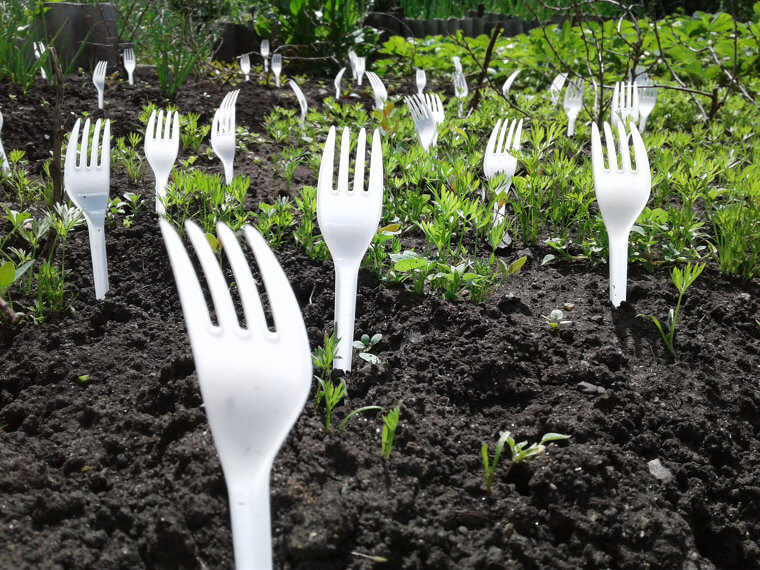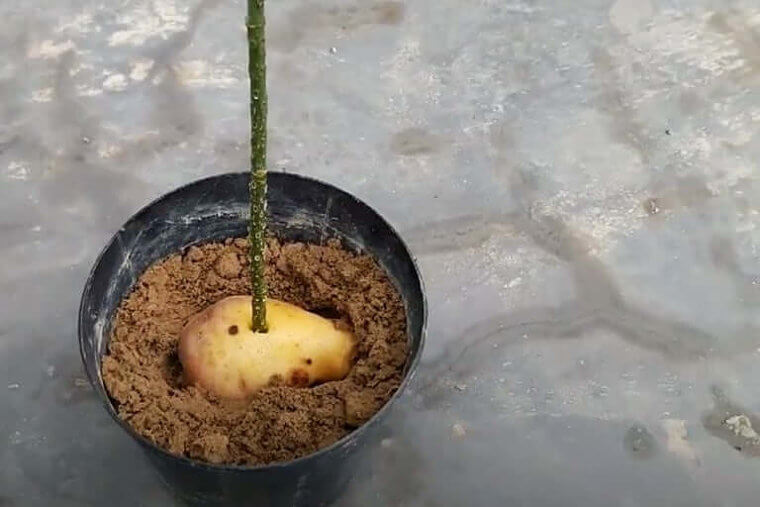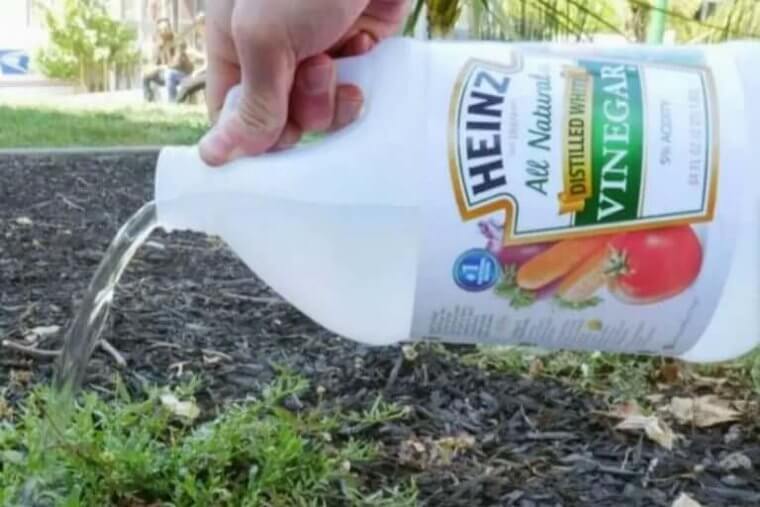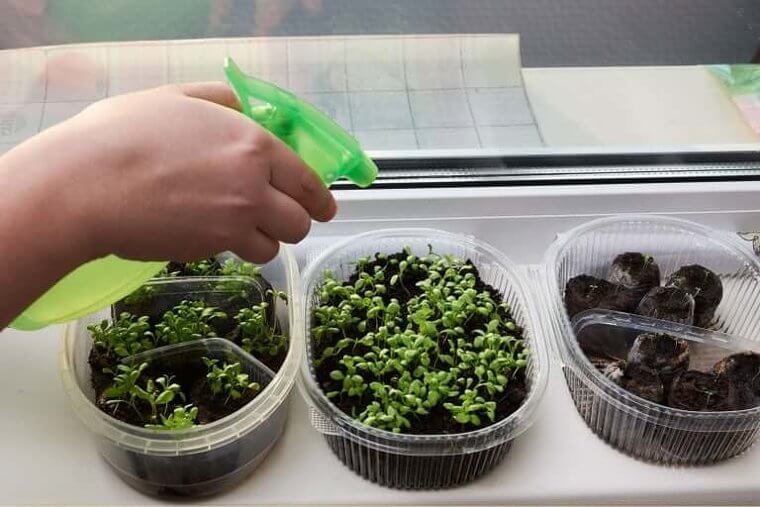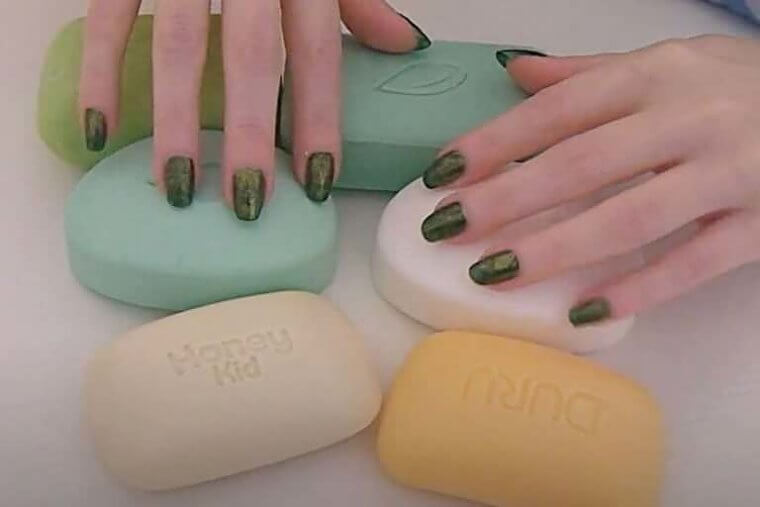This article was originally published on TheEcoFeed
Newspaper Weed Remover
Good news, we finally found a way to make use of all of those old newspapers you have lying around your house. No need to carry them to the recycling bin--apparently, old newspapers can be used to stop weed growth. That's right, newspapers serve as a great weed remover.
Spread the newspaper sheets in an even layer and sprinkle some soil on top. Since the paper is thin, moisture and water can still come through when rain falls or when you water your plants. It also creates a barrier that stops weeds from spreading around your garden. Perfection.
Bottle Greenhouses
In another form of recycling, this is a great use for old plastic bottles, which can be used very effectively as small greenhouses. Just cut the bottom off the bottle, pour some soil and sufficient water in. Then, add seeds or plant cuttings, or whatever it is that you want to grow.
Then, re-seal the lid, and let it grow in its little pod. Your new mini-greenhouse will give the plants perfect humidity and comfort, making things ideal for them to thrive. Place them in front of a window or any other sunny space, and you should be good to go. Once they're big enough, take the plants out of the greenhouse and plant them outside.
DIY Watering Can
We all know how frustrating it can get to water your indoor plants when an outdoor watering can is simply too big. So, what's the solution? Take an old gallon jug and poke holes in the lid with a knife screwdriver.
Then, put the lid back on again, and you have your very own watering can. The perfect use for discarded milk jugs you don't want to use, and fun for adults and kids alike. Amazing.
Sponges Against Root Rot
It can be hard to keep plants alive. We all know this, and we've all been there. Sometimes it doesn't matter how much we want those plants to live, they just don't make it. One reason for this is root rot; we simply love and water our plants TOO much. They have too much water in the bottom of their pots and it kills them.
So what's a great resolution to this common problem? Believe it or not, the common kitchen sponge is. If you put a plain old sponge at the bottom of the pot before covering it with soil, there will be no harm done if you overwater your beloved plant again. Instead, any excess water will be soaked up into the sponge rather than sit in the bottom of the pot and damage the roots.
Classic Plant Pots Are So Last Year
This trick is for those who like to think outside of the box and look for new ways to decorate their garden and spice up the way their flowers look. That's right, even the most unrelated object can be made into the perfect plant holder--even a shoe organizer.
Simply poke a few holes into the bottom of the pots in order to allow water to drain through, then hang it up on a wall to make a great wall hanging. After that's done, simply remember to water regularly, and enjoy your new green decor.
Innovative Idea For Wine Lovers
This one is for all you wine lovers who keep a collection of old wine corks. Rather than throwing them away, these little guys can make absolutely beautiful and charming garden labels.
Just grab your Sharpie and label each cork with the plant it's placed into. Then, glue the cork to a toothpick, and stick it in the pot. The result will look cute and organized, and you will never confuse your parsley for your cilantro again.
Grow Onions In A Jar
Growing onions in a jar may sound like a strange concept on paper, but hear us out for a second. In reality, it works like magic. The next time you cut up some green onions, keep some scraps with the roots still attached. Then, find an old jar.
Fill the jar about halfway up with water, then place the bottom bit of the onion root in the jar. The water should only cover the bottom of the root. Then all you have to do is wait and see what the end result will be. In other words, watch those onions grow.
The New Scarecrow
Leftover plastic utensils--we all know how bad for the environment they are, and yet we always have some on hand. But don't fret! Here's a great way to reuse disposable plastic forks: use them as mini scarecrows to scare away small animals such as squirrels, rabbits, and mice from your garden.
Just stick the forks handle down into the soil, with the prongs and pointy bits sticking out the top. Keep them spread apart around the area that you are trying to protect, to keep unwanted critters away from your budding veggies. Hooray!
Toilet Roll Plant Babies
When plants are little seedlings they need their own space, care, and love. Much like human babies, actually. A way to care for them is to use up old toilet paper rolls you may have in your house. Use the leftover rolls as an organizing tool for germinating seeds before planting them outdoors for maximum eco-friendliness.
Put the empty rolls on a tray, then fill them with soil. Choose whichever seeds you want, and when they are ready you can transfer them to the garden, still in the roll. The cardboard roll will decompose in time, so you don't need to worry about it. By the time the roll decomposes, the plant will be strong enough to hold without its support. Beautiful.
Readily Accessible Fertilizer
Who needs compost? With this cool trick, simply save your kitchen scraps and collect them in a bag or container for about a week. Once the week is up, simply pour the food waste into the ground to act as compost.
Dig a hole in the ground, then bury the scraps inside this whole, and the soil will love you for it. The nutrients from the leftover food will give the plants new life, so just wait and watch them grow.
Curious Rose/Potato Combination
No we're not crazy, we know this sounds weird but it does actually work. For some reason, roses love to grow straight out of potatoes. First, get a nice bouquet of roses and enjoy their natural beauty. Then, wait until the moment when it looks like they are starting to wilt.
This is when you grab some potatoes. Poke a hole in each one. Insert the end of the rose stem into the hole, bury the potato and bottom of the rose into the ground, and wait until your rose garden blooms. Do this with as many roses and potatoes as you want, and watch your own rose bush begin to grow. Amazing!
Muffin Tin Magic
One thing you have to make sure of, when gardening, is that you don't overcrowd your plants and keep them too close to each other. Just like humans, plants need space too. A way to make sure this happens is by taking a muffin tin and pressing it into the soil to outline some little holes for the plants to go in.
This looks neatly organized AND is really helpful, the ideal combination. This handy tip will both save money, make your plants last longer, and save you hassle and effort. Plus, once the tin is in use, muffins do seem like a really great idea...
Grow Your Own Veggies
This is actually way easier than you would think, as all you need are the seeds that are already found inside store-bought vegetables, such as the inside of that bell pepper you just cut up for your salad.
Place the seeds inside a shallow tray of soil, and keep it watered. Then, before you know it, you will be growing your very own peppers which will taste delicious. You can do this with tomatoes too.
Easy Homemade Weed Killer
Weeds are every gardener's worst nightmare, but we also hate the idea of pouring loads of harsh chemicals onto our garden. It's not good for us, our gardens, or the wildlife there.
So, in order to make your own weed destroyer that isn't full of toxic chemicals, you only need a few things. Mix together a gallon of vinegar, a cup of salt, and a tablespoon of dish soap. Shake the mixture together then spray it on the weeds on a sunny day, and voila. A weed-free solution, at your disposal.
Mini Greenhouse Containers
This is the perfect use for those plastic takeaway containers that you have laying around in your house. Any plastic container will work for this, all you need is a little dedication and a bit of soil.
This helps protect seedlings from pests and gives them a safe place to grow. Just place the lid on once the soil and seeds are in, and you've made your own little takeaway plastic greenhouse.
A Secret Use For Weeds
So weeds AREN'T just useless. They can actually serve in creating some amazing garden water. Place your weeds in a bucket and cover them with water, this will then soak up all the weeds' nutrients rather than them going to waste.
Leave for a few hours, then get rid of the weeds (now they really are useless). The weed water can be used to water your garden, and your plants will absolutely love all those extra nutrients you're feeding them.
Filtering Out The Dirt
This trick using coffee filters works for both indoor and outdoor plants. Placing a coffee filter on the inside of a pot before adding soil means that you're less likely to make a mess with soil being spilled everywhere when you fill the pot up.
This thin barrier between the plant and the pot's drainage hole could end up making all the difference. The soil will stay loose instead of slipping through the hole, and the water will drain naturally. The only problem? Potentially less coffee.
Soap Pest Deterrent
We love our plants so much, but unfortunately, other, less desirable creatures happen to love them too. Deer, rabbits, and squirrels all love the taste of the plants we pour our hearts into, which can be heartbreaking for us novice gardeners. Why not use soap to keep them away?
Shred or grate some soap, and sprinkle the soapy bits over the place where your plants are growing. The animals hate the taste of soap (as we all do) so it will effectively keep them away. Pests, be gone!
Salty Fertilizer
A sprinkle of salt usually makes delicious food even more delicious, but that's not the only use for it. It's actually also helpful in the garden. Either sprinkle some salt straight onto the flowerbed, or mix it with some water to make low-budget fertilizer.
Pour some saltwater to the base of your plants for a healthy dose of nutrients. This will serve just as effectively as any other fertilizer would, and it's easier and cheaper.
Weeding Magic
Sometimes we want to get rid of pesky weeds, but we don't want to destroy any other plants around them in the process. So what should we do? Take an ordinary aluminum can and remove the top and bottom. Then, place it around the specific patch that we want to target.
You can simply use a can opener to remove the two ends, then the weed killer should just be sprayed directly inside the hole. The result of this will be a garden that still looks fresh, clean, and healthy other than the small patches you decided to get rid of.
Plastic Bottles Life Saviors
Root rot is such a pain, since so many pots are closed, it can be hard to see if there's too much water resting at the bottom of the plant, and the results can be disastrous. Don't worry though, we have a solution that can fix this problem AND put your old plastic bottles to good use, so it's also good for the environment.
Simply stick your old, empty bottles in the bottom of a bigger pot that you're using to plant a small tree, or large bush. Then place the soil on top. This will help elevate the whole bedding of the plant and any unwanted water will drain to the bottom. Also, the plant will fit better into the pot. So much good news.
The Handy Zip Tie
Plants that grow tall, like sunflowers or vines, can be placed next to a small stick, a chopstick, or any other similar object that will help their stem grow vertically. Then, if you want to REALLY help them on their way up and towards the sun, bring out the zip ties.
This secret use of zip ties is a life-saver, as you simply attach the tie around both the plant and the stick to keep them nicely secured. Trim any leftover tie you have hanging off at the end, and your plant will thank you as it is now ready to grow taller than ever before.
Drinking A Pint With The Slugs
Slugs are one of the garden's biggest menaces, as you probably already know. They're slimy, and they eat through plants, making them a huge hassle for the average gardener. Even if they are just making their way through your green patch, this can ruin the veggies they cross on their path. So here's the solution: beer.
Much like humans, slugs are drawn to beer. So simply pour a shallow glass of beer, place it in the garden somewhere, and the slugs will gravitate towards it. Once they are there, the liquid prevent them from getting out again. The perfect slug trap that your garden will definitely thank you for.
Cinnamon Ant Bomb
Ants are another super annoying pest that nobody is happy about finding in their garden. But don't worry, if they do come there is actually a very easy way to get rid of them. All you have to do is look inside your cupboard and pull out the cinnamon. Not just a delicious spice, but a helpful tool too.
Sprinkling cinnamon on top of plants will have no effect on the plants themselves, but it will act as an amazing deterrent for ants in the garden. Ants hate the smell of the delicious spice, so they will stay far away. Also, putting some cinnamon on the stem of a new plant cutting will help it grow faster, so there's another cinnamon top tip.
The Cutest Natural Plant Pots
Sometimes we don't have enough plant pots, especially for little seedlings we want to help grow. The solution? Easy, just use old orange peels. Cut an orange in half, scoop out the delicious inside, place the soil in, and you have your very own natural and organic plant pot holder.
Poke a few holes in the bottom for drainage purposes, and make sure you choose the right kind of seeds. Since the citrus is acidic, choose the seed of an acid-loving plant such as radishes and peppers. Then wait for the results.
Cardboard For Stopping Weeds
A weed-free garden is every gardener's absolute dream, and we have the news that can help this dream become a reality. Before putting new soil down, place a thin sheet of cardboard underneath. Much like newspaper sheets, cardboard is a gardener's ally in the garden.
The cardboard sheets will soak up any water that you put onto the plants, which will help to keep the soil moist. This in turn will make it impossible for weeds to pierce through the cardboard layer, and the plants will remain healthy and weed-free. Just remember to dismantle some cardboard boxes in order for this to work.
Yet Another Use For Epsom Salt
Epsom salt is well known for its home remedy uses, having powerful properties that many people swear by. Well, here's yet another great use for Epsom salt: as a fertilizer. Since the salt is made of magnesium, it's perfect for the job.
It can help with seed germination, chlorophyll production, and help plants absorb the vital nutrients they need to grow strong and healthy. Simply mix the salt with water, then spray it onto the plants. A good ratio is two teaspoons of salt to one gallon of water. Apply this mixture once a month, and your vegetable and rose plants will really love you for this.
Rust Prevention Hack
If we leave our tools in the garden shed without use for too long, they can quite quickly become rusty. This is not something that any gardener wants. There's a simple way to avoid this, which involves mixing a bag of sand with mineral oil, even with baby oil if it's more readily available.
Then pour the mixture into a bucket and place your gardening tools inside. This will not only clean the tools, but also keep them from rusting. Furthermore, you'll never lose your tools again as you'll know that they are all stored in one place.
Plastic To Keep The Plants In Place
Some plants have roots that just spread for days, and if you don't keep them contained they could take over the space that is meant for other plants. These overgrown roots can be a pain, so a good way to keep them under control is by using the plastic pots the plants initially come in.
Rather than removing the plant from the plastic pot it comes in, just bury the whole thing in the soil: pot and plant together. The pot should be a bit bigger than the plant inside, but this will make sure the plant stays put in one place.
Baking Soda For Sweeter Tomatoes
Who doesn't want their tomatoes extra sweet? We know we do. Surprisingly, baking soda is a great way to make your tomatoes as sweet as you want them to be. Just need to sprinkle the white powder around the base of your tomato plants. Make sure you don't accidentally powder the leaves or roots, because this can potentially damage them.
Another way to make this work is by adding a teaspoon of baking soda into a gallon of water, mix it up so it's disolved, then pour this mixture around the base of your plants. Just be careful not to touch the actual plant, and the end result will be some sweet and scrumptious tomatoes.
The Self-Watering Wine Bottle
This one is perfect for anyone going away on a mini-break and leaving their plants at home alone. Just take an empty wine bottle (wash it first), then make a small hole in the cork. Fill the bottle with water, and put the cork back in.
Turning the bottle upside down, the water will slowly drip out in droplets at a slow and steady pace, as you stick the bottle, cork facing down, into the soil. This will help keep the soil full of moisture, and you don't have to worry about the plant drying out.
Strawberries In The Laundry Basket
Growing your own strawberries is always fun, but the delicious fruits are known for needing a lot of room to grow in. We have a perfect container suggestion: a laundry basket. Fill a plastic laundry basket with a plastic garbage bag, and pierce with a few small holes in the sides of the bag. Then fill the basket with soil.
Place the strawberry seeds in the holes that you cut on the sides of the basket, making sure to keep space between them. Planting them is the hardest bit, but once they're in all you need to do is water your plant baby, making sure you soak both the sides and the top of the basket. After that, your 360-degree garden is ready.
Grow Your Own Avocado
Growing your own avocado is easy and fun, you just have to save the pit from the last delicious avocado you had. After cleaning the pit, stick three toothpicks into its sides. Then place the pit in a glass of water. The water should just reach the base of the pit.
Once the roots start to sprout, place the pit in a soil-filled pot and keep watering the soil so it stays full of moisture. Within a few weeks, you will be the proud owner of your very own small avocado tree. Adorable.
Seed Sorting Units
If you're a keen gardener you're probably going to find yourself with lots of leftover seeds that you might get confused about. A simple way to store these is by placing them in old RX bottles which can keep them fresh for up to five years.
Rinse the bottles and seeds, and wait until both are completely dry. Then place the seeds inside the bottles with your own handmade labels, and store them in a cool, dry place until the time comes when you're ready to plant.
Make Your Own Succulent
This hack will make you feel like a mad scientist, creating new life all on your own. In order to make a new succulent, take one empty plastic water bottle. Remove the cap and poke holes in the side of the bottle.
Fill the base of the bottle with two inches of water, then remove some of the petals of an existing succulent and place them root-side into the bottle. Put the cap back on, and leave the bottle in a window. Soon you'll see the new sprouts, and after four weeks you can plant them in soil.
Roping The Plants Together
This hack is great for when you leave on vacation. Just gather all your plants together, and place them around a table. Then fill a vase with water on top of the table. Next, you will need to cut lots of long pieces of rope.
Each rope will have one end in the soil of a plant, and one end in the water. The rope will absorb and move the water from the pot to the plant when the soil is dry. Gravity is your friend here, and your plants will stay alive.
Clean Fingernail Trick
How annoying is all that dirt stuck under your fingernails when you finish your gardening duties? Well, not anymore. Instead of having soil under your nails, before you head out into the garden, scratch some soap to get it to fill the gap under your nails.
This way there will no room for the dirt to get stuck in. The best bit is, once you wash your hands all of the soap will dissolve with the water and you'll be left with cleaner nails than ever.
Environmentally Friendly Planters
We're all about upcycling, and using old plant tires as planters is a super cool idea. You can either paint them or leave them untouched, but they will look great nonetheless.
Cut a circular cardboard piece and put it at the bottom of your new tire planter to stop soil from spilling out. Then simply add soil. You can choose if you want to stack up the tires or place them in a line. The finished look is up to you.
Gorgeous Gutter Garden
Why let your old gutters go to waste? We're very fond of the idea of using any old scrap as a planting utensil, and old gutters are another great solution. Add soil and seeds to your gutter and water the finished products just like you would any store-bought planter.
In no time at all your gutter will become a beautiful new garden space, and it can be placed anywhere in the garden for a visual green treat. Once the sprouts are big enough to be planted in the ground, you can clean the gutter then add more seedlings. The cycle continues.
Spray The Bugs Away
There's nothing more annoying than realizing that the bugs got to your veggies before you, after you've put so much hard work into helping them grow! In order to stop this from happening, we suggest our homemade bug spray to help the garden grow pest-free.
In a blender, simply mix these ingredients: one head of garlic, one and a half cups of mint leaves, one teaspoon of cayenne pepper, six cups of water, and a splash of dishwasher liquid. Mix this all together, then spray it onto your plants from a spray bottle. All the ingredients can be found in your home, and it really works a charm.








